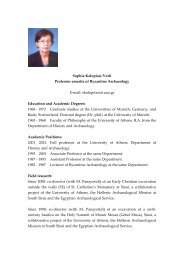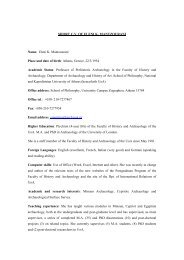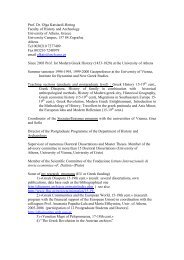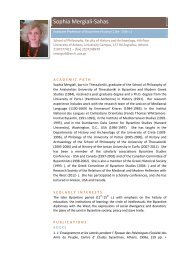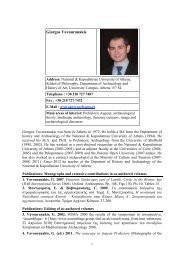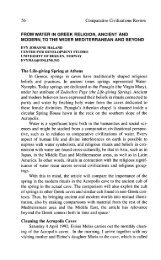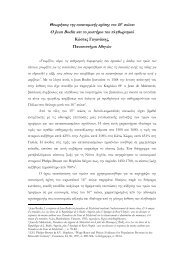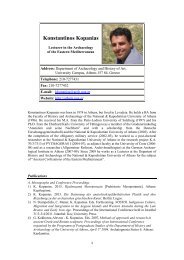OLGA PALAGIA The Marble of the Penelope from Persepolis and Its ...
OLGA PALAGIA The Marble of the Penelope from Persepolis and Its ...
OLGA PALAGIA The Marble of the Penelope from Persepolis and Its ...
You also want an ePaper? Increase the reach of your titles
YUMPU automatically turns print PDFs into web optimized ePapers that Google loves.
example at <strong>The</strong>spiai, where we are told that a work <strong>of</strong> his <strong>of</strong> unknown subject<br />
was restored by Pausias in <strong>the</strong> fourth century BC (Plin. HN 35.123). A<br />
seated <strong>Penelope</strong> contemplating her fate could easily have formed part <strong>of</strong><br />
any number <strong>of</strong> Odysseus compositions. It has been suggested that <strong>the</strong> pictorial<br />
prototype <strong>of</strong> <strong>the</strong> seated <strong>Penelope</strong> was invented by Polygnotos in his<br />
painting at <strong>The</strong>spiai." But o<strong>the</strong>r possibilities present <strong>the</strong>mselves, not least<br />
a picture <strong>of</strong> <strong>the</strong> massacre <strong>of</strong> <strong>the</strong> suitors, with which indeed she seems to be<br />
associated on <strong>the</strong> New York ring on account <strong>of</strong> <strong>the</strong> addition <strong>of</strong> Odysseus'<br />
bow. <strong>The</strong> attribution <strong>of</strong> <strong>the</strong> <strong>Penelope</strong> prototype to Polygnotos is an attractive<br />
suggestion that goes back a long way <strong>and</strong> has met with wide acceptance.<br />
In addition, Pliny (HN 34.85) reports <strong>the</strong> little-known fact that Polygnotos<br />
was not only a famous painter but also a bronze sculptor. It is not unlikely<br />
that he may have turned his own design into a statue. But this remains<br />
in <strong>the</strong> realm <strong>of</strong> speculation.<br />
<strong>The</strong> appearance <strong>of</strong> an 'original' Greek marble version at <strong>Persepolis</strong> has<br />
generated endless discussion as to its provenance, date, <strong>and</strong> relation to <strong>the</strong><br />
Roman copies <strong>and</strong> adaptations, which were obviously based on ano<strong>the</strong>r<br />
original that survived into <strong>the</strong> Roman imperial peri0d.2~ A case <strong>of</strong> two<br />
identical originals is attested before this time by <strong>the</strong> bronze Apollo Milesios<br />
by Kanachos, carried away by Darius I in 493 BC, <strong>and</strong> its wooden contemporary<br />
replica by <strong>the</strong> same artist in <strong>The</strong>besu One assumes a duplicate<br />
dedication, especially as later replicas <strong>of</strong> earlier types are unheard <strong>of</strong> in <strong>the</strong><br />
archaic <strong>and</strong> classical periodsz3 Such retrospective tendencies are only common<br />
<strong>from</strong> <strong>the</strong> first century BC onwards.<br />
<strong>The</strong> <strong>Persepolis</strong> statue (Rg. 1) has been considered a marble copy <strong>of</strong> a<br />
bronze original or a second marble original. <strong>The</strong>re is no consensus over its<br />
date. Most scholars place her in <strong>the</strong> decade 460-450 BC but she is probably<br />
closer to <strong>the</strong> mid-fifth century on account <strong>of</strong> her affinity to <strong>the</strong> Par<strong>the</strong>non<br />
frieze. A minority view considers her ei<strong>the</strong>r a High Classical or a Rich<br />
Style imitation <strong>of</strong> a Severe Style prototype despite <strong>the</strong> fact that we have<br />
no evidence <strong>of</strong> reproductions <strong>of</strong> Severe Style originals in <strong>the</strong> second half<br />
<strong>of</strong> <strong>the</strong> fifth century.24 <strong>The</strong> more 'archaic' appearance <strong>of</strong> <strong>the</strong> Roman copies<br />
has prompted <strong>the</strong> suggestion that <strong>the</strong> <strong>Persepolis</strong> statue was created one,<br />
two or more decades after <strong>the</strong> putative prototype which is reflected in <strong>the</strong><br />
Vatican copies. It is not safe, however, to make stylistic arguments based<br />
on Roman copies, as <strong>the</strong>se may be contaminated by retrospection or o<strong>the</strong>r<br />
tendencies. <strong>The</strong> stylistic differences detected between <strong>the</strong> <strong>Persepolis</strong><br />
torso <strong>and</strong> <strong>the</strong> Roman copies need not reflect two originals created at different<br />
times but may be attributed to <strong>the</strong> whims <strong>of</strong> <strong>the</strong> copyists. On present<br />
evidence, it is safer to assume that two versions <strong>of</strong> <strong>the</strong> <strong>Penelope</strong> were<br />
created at <strong>the</strong> same time, that is, around <strong>the</strong> middle <strong>of</strong> <strong>the</strong> fifth century, in<br />
order to be set up at different locations.25 Because <strong>the</strong> <strong>Persepolis</strong> statue<br />
was created long after <strong>the</strong> Persian raids <strong>of</strong> <strong>the</strong> first quarter <strong>of</strong> <strong>the</strong> fifth century,<br />
it was probably not loot but a gift <strong>from</strong> a Greek city to <strong>the</strong> Great<br />
<strong>The</strong> historical context may well be mounting opposition against<br />
A<strong>the</strong>nian oppression in <strong>the</strong> middle years <strong>of</strong> <strong>the</strong> century, when <strong>the</strong> Delian<br />
League was gradually transformed into an A<strong>the</strong>nian empire. After <strong>the</strong> disaster<br />
<strong>of</strong> <strong>the</strong> A<strong>the</strong>nian fleet in Egypt in <strong>the</strong> mid-450s <strong>the</strong>re were movements<br />
<strong>of</strong> rapprochement between Ionian cities <strong>and</strong> <strong>the</strong> Persians, e.g., Erythrai<br />
<strong>and</strong> Milet~s.~~ In 440139 Samos solicited Persian support in its attempt to<br />
secede <strong>from</strong> <strong>the</strong> A<strong>the</strong>nian allianceZs <strong>and</strong> <strong>the</strong>re may have been o<strong>the</strong>r, unrecorded<br />
cases <strong>of</strong> allies looking eastward.



